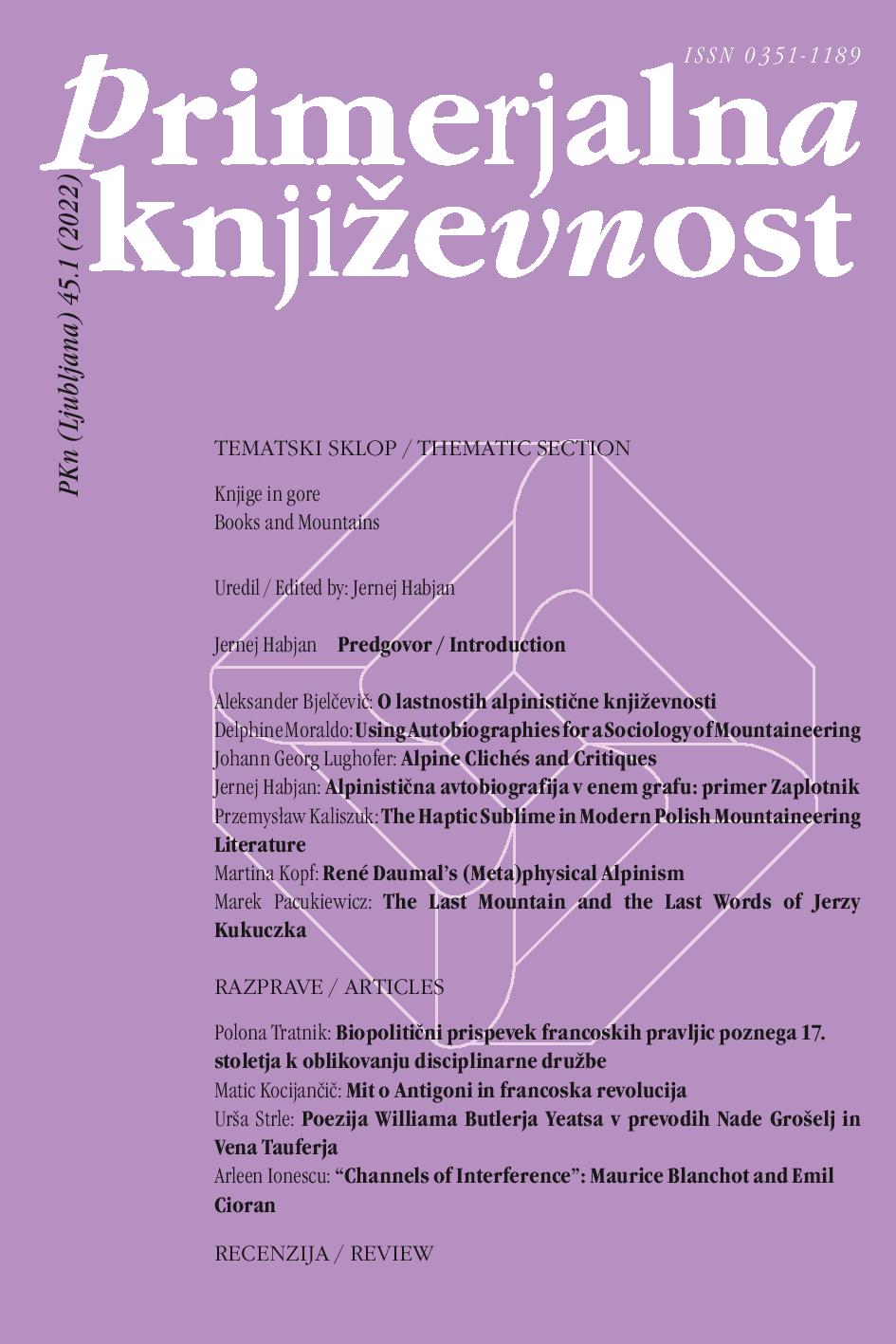Biopolitical Contribution of the French Late Seventeenth-Century Fairy Tales to the Formation of Disciplinary Society
DOI:
https://doi.org/10.3986/pkn.v45.i1.08Keywords:
French literature, 17th century, fairy tales, court society, aristocracy, civilizing process, Perrault, Charles, Aulnoy, Marie-Catherine, Cinderella, women, gender roles, biopoliticsAbstract
In the article, I address the formation of a disciplinary society, as reflected in the aristocratic culture of French storytellers at the end of the seventeenth century. Fairy tales played an important role in what Norbert Elias called the civilizing process. In the case of fairy tales, this meant the formation of a polite court society as well as disciplining women. I explore the biopolitical aspects of fairy tales in those circumstances, as it is at that time that fairy tales show social shifts and consolidation of certain concepts, especially a particular concept of femininity and a particular social role of women, which remain largely unchanged also later on. I analyze the tale of Cinderella as written by two different authors, Charles Perrault and Marie-Catherine d’Aulnoy. I compare them as regards the representation of gender, gender roles and relationships, as well as their messages and morals. In the second half of the twentieth century, thanks to Walt Disney’s adaptation of Perrault’s Cinderella, this version became the world’s most famous fairy tale about Cinderella. The biopolitical relevance of Perrault or Disney’s Cinderella as arguably the most globalized story in general has been and still is remarkable.
References
Beasley, Faith Evelyn. »Changing the Conversation: Re-positioning the French Seventeenth-Century Salon«. <em>L'Esprit Créateur</em> 60.1 (2020): 34–46.
Beasley, Faith Evelyn. <em>Revising Memory: Women’s Fiction and Memoirs in Seventeenth-Century France</em>. New Brunswick, NJ: Rutgers University Press, 1990.
Beasley, Faith Evelyn, ur. <em>Teaching Seventeenth- and Eighteenth-Century French Women Writers</em>. New York, NY: MLA, 2011.
Betts, Christopher. »Explanatory Notes«. <em>The Complete Fairy Tales</em>. Avtor Charles Perrault. Oxford: Oxford University Press, 2009. 196–204.
Betts, Christopher. »Introduction«. <em>The Complete Fairy Tales</em>. Avtor Charles Perrault. Oxford: Oxford University Press, 2009. ix–xxxvii.
Bottigheimer, Ruth. »Fertility Control and the Birth of the Modern European Fairy-Tale Heroine«. <em>Marvels & Tales</em> 14.1 (2000): 64–79.
Burcar, Lilijana. »Pozabljene literarne pravljice francoskih salonskih pisateljic«. <em>Slavistična revija</em> 68.2 (2020): 197–210.
Lougee, Carolyn C. <em>Le Paradis des Femmes: Women, Salons, and Social Stratificaiton in Seventeenth-Century France</em>. Princeton, NJ: Princeton University Press, 1976.
D’Aulnoy, Marie-Catherine. »Drobtinica Pepelka«. <em>Pavji kralj in druge pravljice</em>. Ljubljana: Mladinska knjiga, 1987. 121–142.
D’Aulnoy, Marie-Catherine. »Finette Cendron«. <em>The Great Fairy Tale Tradition: From Straparola and Basile to Brothers Grimm</em>. Ur. Jack Zipes. New York, NY; London: W. W. Norton & Company, 2001. 454–467.
DeJean, Joan. <em>Tender Geographies: Women and the Origins of the Novel in France</em>. New York, NY: Columbia University Press, 1991.
de Rougemont, Denis. <em>Ljubezen in Zahod</em>. Ljubljana: Založba *cf., 1999.
Elias, Norbert. <em>The Court Society</em>. Oxford: Basil Blackwell, 1983.
Elias, Norbert. <em>O procesu civiliziranja. Prvi zvezek</em>. Ljubljana: Založba *cf., 2000.
Farrell, Michele. »Celebration and Repression of Feminine Desire in Mme d’Aulnoy’s Fairy Tale: <em>La Chatte Blanche</em>«. <em>L’Esprit Créateur</em> 29.3 (1989): 52–64.
Foucault, Michel. <em>»Družbo je treba braniti«. Predavanja na Collège de France (1975–1976)</em>. Ljubljana: Studia Humanitatis, 2015.
Hannon, Patricia. »Antithesis and Ideology in Perrault’s ‘Riquet à la houppe’«. <em>Cahiers du Dix-Septième: An Interdisciplinary Journal</em> 4.2 (1990): 105–117.
Hannon, Patricia. »<em>Corps cadavres</em>: Heroes and Heroines in the Tales of Perrault«. <em>The Great Fairy Tale Tradition: From Straparola and Basile to Brothers Grimm</em>. Ur. Jack Zipes. New York, NY; London: W. W. Norton & Company, 2001. 933–957.
Hannon, Patricia. <em>Fabulous Identities: Women’s Fairy Tales in Seventeenth-Century France</em>. Amsterdam; Atlanta, GA: Rodopi, 1994.
Hannon, Patricia, in Anne E. Duggan. »French Tales«. <em>The Greenwood Encyclopedia of Folktales and Fairy Tales</em>. Ur. Donald Hasse. Westport, CT; London: Greenwood Press, 2008. 379–388.
Harth, Erica. <em>Cartesian Women: Versions and Subversions of Rational Discourse in the Old Regime</em>. Ithaca, NY; London: Cornell University Press, 1992.
zum Kolk, Caroline, in Wilson-Chevalier, ur. <em>Femmes à la cour de France: Charges et fonctions (XVe–XIXe siècle)</em>. Lille: Presses Universitaires du Septentrion, 2018.
Lancelyn Green, Roger. »The Girl with the Rose-Red Slippers«. <em>Tales of Ancient Egypt</em>. New York, NY: Puffin Books, 1970. 180–184.
Luthi, Max. <em>The European Folktale: Form and Nature</em>. Bloomington, IN: Indiana University Press, 1984.
Perrault, Charles. »Cinderella: or, The Glass Slipper«. <em>The Complete Fairy Tales</em>. Avtor Charles Perrault. Oxford: Oxford University Press, 2009. 130–141.
Perrault, Charles. »Preface«. <em>The Complete Fairy Tales</em>. Avtor Charles Perrault. Oxford: Oxford University Press, 2009. 3–7.
Roalfe Cox, Marian. <em>Cinderella: Three Hundred and Forty-Five Variants</em>. London: Folklore Society, David Nutt, 1893.
Seifert, Lewis C. <em>Fairy Tales, Sexuality, and Gender in France, 1690–1715: Nostalgic Utopias</em>. Cambridge; New York, NY: Cambridge University Press, 1996.
Seifert, Lewis C. »On Fairy Tales, Subversion, and Ambiguity: Feminist Approaches to Seventeenth-Century Contes de fées«. <em>Marvels & Tales</em> 14.1 (2000): 80–98.
Reiss, Timothy J. <em>The Meaning of Literature</em>. Ithaca, NY: Cornell University Press, 1992.
Tatar, Maria. <em>The Annotated Classic Fairy Tales</em>. New York, NY; London: W. W. Norton & Company, 2002.
Tratnik, Polona. »Pravljica: družbena resničnost in mirabilis – s posebnim ozirom na renesančne različice pravljice o Pepelki«. <em>Studia Historica Slovenica: časopis za humanistične in družboslovne študije</em> 20.2 (2020): 957–984.
Zipes, Jack. <em>The Trials and Tribulations of Little Red Riding Hood: Versions of the Tale in Sociocultural Context</em>. New York, NY; Oxon: Routledge, 1993.
Zipes, Jack. »Cross-Cultural Connections and the Contamination of the Classical Fairy Tale«. <em>The Great Fairy Tale Tradition: From Straparola and Basile to Brothers Grimm</em>. Ur. Jack Zipes. New York, NY; London: W. W. Norton & Company, 2001. 845–869.
Zipes, Jack. »Introduction«. <em>The Great Fairy Tale Tradition: From Straparola and Basile to Brothers Grimm</em>. Ur. Jack Zipes. New York, NY; London: W. W. Norton & Company, 2001. xi–xiv.
Zipes, Jack. <em>When Dreams Come True: Classical Fairy Tales and Their Tradition</em>. New York, NY; London: Routledge, 2007.
Zipes, Jack. <em>Fairy Tales and the Art of Subversion</em>. New York, NY; Oxon: Routledge, 2012.


